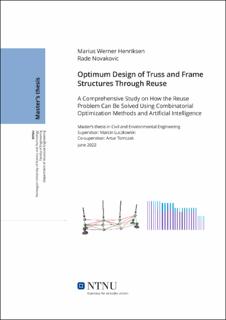| dc.description.abstract | Economic development has historically relied on increasing material demand, which has led to growing energy consumption and carbon dioxide emissions. Today, structural elements used in buildings are typically
designed for a single use and purpose. At the end of the lifespan, buildings are demolished, and some elements are recycled. As the output of constructions multiply worldwide, the damaging effects on the environment will only escalate. This thesis aims to explore the design of truss and frame structures
through reuse. A series of Grasshopper components have been made as a means to investigate different structural optimization techniques given a stock of reusable elements.
In opposition to using a commercial finite element analysis solver and ignoring the complexity of structural analysis, a taylor-made program for solving truss and frame systems was developed to verify the models as quickly as possible with full transparency and understanding of the methods. The solver was benchmarked in a case study against Autodesk: Robot Structural Analysis and proven to be accurate, deviating only 0.047% and 0.023% for displacements and rotations, respectively. Moreover, program achieved utilization results as expected considering the assumptions. In addition, a concept for automating load application was developed using the gift wrapping method.
The three primary reuse methods developed and scrutinized in the case studies are brute force, heuristics and branch and bound. The brute force and heuristics are implemented with the possibility to include cutting, i.e. a method which allows for elements to be used in multiple positions in the structure. The reuse methods were examined through four different case studies designed to yield as much valuable insight as possible. The research on life cycle assessment and the financial implications of reuse suggested upper bound potential to reduce carbon equivalents by 88% with a 49% additional cost. Relative size and correctness in terms of length
and profiles of reuse elements in the material bank with reference to the structure and the load situation was significantly influencing the life cycle assessment and the monetary cost results. Moreover, considerable deviations between the methods in terms of optimization and computation times suggested big potential in improving and adapting the combinatorial optimization technique. The heuristics method generally achieved the superior results while also obtaining the calculations faster than the other methods. However, both brute force and branch and bound are search techniques with the potential to conclusively find the optimal
solution unlike heuristics and should not be discarded.
Furthermore, the machine learning platform Tensorflow was used with the API Keras to explore how artificial neural networks can be used to predict multiple objective values based on a set of benchmarks related to optimization. In the case study the neural network attempts to predict maximum displacement and the LCA value (associated with reuse). The best result achieved was a mean error of 9.91% and 0.15% in the prediction for displacement and LCA, respectively. | |
